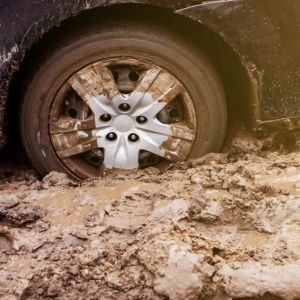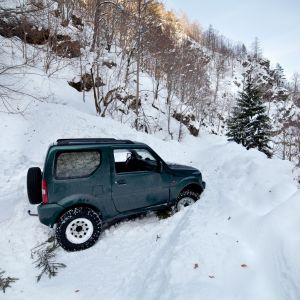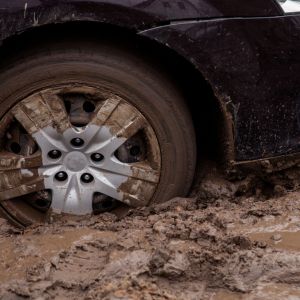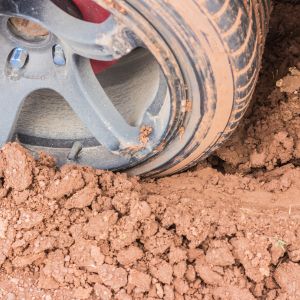Remember to exercise caution and be mindful of your surroundings when attempting to get your car out of mud or snow. If you’re not confident in your ability to get your car out when car gets stuck in the mud, it’s best to call for professional help.
It’s important to take precautions to prevent snow-related damage to your car. This can include avoiding driving in snow whenever possible, preparing your car for winter driving, and avoiding spinning your wheels or leaving the car running while stuck in snow. If your car gets stuck in the mud, it’s best to call to car towing service provider company for a tow truck or other professional assistance to prevent further damage to your car.
How do you get out of mud and snow?

Getting out of mud or snow can be a challenging task for a driver, but with the right steps, it can be done safely.
Assess the situation: Before attempting to get out of mud or snow, it’s essential to assess the situation and determine if it’s safe to do so. If the vehicle is in a precarious position or if it’s too dangerous to try and get out, it’s best to stay inside and call for help.
Use a shovel: If you have a shovel, use it to clear the mud or snow around the wheels. This will help provide more traction and make it easier to get out.
Put down something to help with traction: If you have sand, salt, or kitty litter, sprinkle it around the wheels to help with traction. This will help the tires get a better grip and make it easier to get out.
Use the right gear: Make sure the vehicle is in the correct gear for the situation. If you’re stuck in mud, put the car in low gear and use a slow, steady acceleration to get out. If you’re stuck in snow, put the car in low gear and use a slow, steady acceleration to get out.
Rock the car back and forth: If you’re still stuck, try rocking the car back and forth by shifting from forward to reverse. This will help loosen the mud or snow around the wheels and make it easier to get out.
Call for help: If you’re unable to get out of the mud or snow on your own, it’s time to call for help. A tow truck or a friend with a 4×4 vehicle can come and pull you out.
Damages caused to a car by snow

Snow can cause several types of damages to a car. Some of the most common damages include:
Rust: Snow and salt from the roads can mix with moisture and cause rust to form on the car’s body, undercarriage, and other metal parts.
Engine damage: Snow and ice can clog the air intake, causing damage to the engine.
Battery damage: Cold temperatures can affect the car battery’s ability to hold a charge, making it harder to start the engine.
Tires: Snow, ice, and slush can cause significant wear and tear on tires, especially if they are not winter-rated.
Exhaust system damage: Snow and ice can accumulate around the exhaust system, causing damage to the muffler, catalytic converter, and other parts.
Brakes: Snow, ice, and slush can cause the brakes to work less efficiently, increasing the risk of an accident.
Paint damage: Snow and ice can scratch the paint on the car’s body, especially if it is not cleaned off regularly.
To minimize the damage caused by snow, it is recommended to regularly clean your car and have it serviced by a professional mechanic.
Damages caused to a car by mud

Mud can cause several types of damage to a car, if your car gets stuck in the mud including:
Corrosion: Mud can contain salt, dirt, and other elements that can cause corrosion to the undercarriage and other parts of the car.
Engine problems: If mud gets into the engine, it can cause clogging and cause problems with the vehicle’s performance.
Paint damage: Mud can be abrasive and can cause scratches or chipping of the car’s paint, making it look dull and faded.
Wheel and tire damage: If mud gets inside the wheel wells or on the tires, it can cause imbalance and affect the vehicle’s handling and stability.
Suspension damage: If mud accumulates on the suspension components, it can cause them to rust and become worn down over time, affecting the ride and handling of the car.
Electrical problems: If mud gets into the electrical components of the car, it can cause short circuits, electrical issues, and other problems.
It is important to regularly wash your car and clean the undercarriage to prevent mud from causing these types of damages.
Frequently Asked Questions
Q1. What to do if your car gets stuck in the mud?

Ans: If your car is stuck in the mud, you can try the following steps to get it out:
- Shift into a low gear to increase traction
- Turn your wheels from side to side to try to free the car
- Place a sturdy object such as a piece of wood or a rock under the drive wheels for traction
- Use a shovel to dig out the mud around the tires
- If possible, get someone to push the car while you give it gas
- If the car is still stuck, consider calling for a tow truck.
Q2. How do you get out of mud and snow?
Ans: If your car gets stuck in the mud and snow, you can try the following steps:
- Shift into a low gear to increase traction
- Turn your wheels from side to side to try to free the car
- Place a sturdy object such as a piece of wood or a rock under the drive wheels for traction
- Use a shovel to dig out the mud or snow around the tires
- If possible, get someone to push the car while you give it gas
- If the car is still stuck, consider calling for a tow truck or using a winch.
Q3. Can getting stuck in the mud damage your car?
Ans: Yes, if your car gets stuck in the mud can potentially damage your car. The force from spinning the wheels can cause stress on the transmission and drivetrain, and the constant exposure to mud and moisture can cause rust and corrosion.
Q4. Can getting stuck in snow damage a car?
Ans: Yes, getting stuck in snow can potentially damage your car. The force from spinning the wheels can cause stress on the transmission and drivetrain, and if the snow is deep, the car’s exhaust system can become clogged, potentially causing engine damage.
Q5. Who to call when the car is stuck in the snow?
Ans: If your car is stuck in snow, you can call a tow truck or road assistance service for help. You can also call a friend or family member for help, or contact your car insurance company to see if they offer roadside assistance services.

